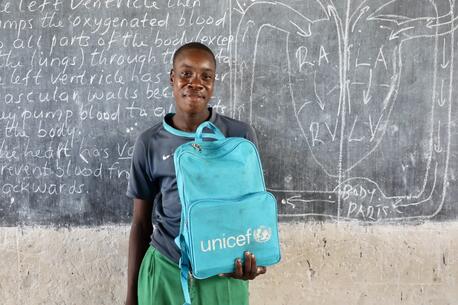
Deadly Cyclones Are On the Rise and Climate Change Is To Blame
Cyclone Fani recently put millions at risk in India and Bangladesh. Meanwhile, Mozambique is still recovering from back-to-back cyclones that tore through the region in March and April, causing serious damage to the lives of thousands of children. These powerful storms should be an urgent wakeup call to world leaders on the grave risks that extreme weather events pose to the lives of children.

"We are witnessing a worrisome trend," said Henrietta Fore, UNICEF's Executive Director. "Cyclones, droughts and other extreme weather events are increasing in frequency and intensity. As we have seen in Mozambique and elsewhere, poorer countries and communities are disproportionately affected. For children who are already vulnerable, the impact can be devastating." Above, on March 24, 2019 in Beira, Mozambique, people walk in an area that was flooded after Cyclone Idai made landfall. © UNICEF/UN0296522/Prinsloo

One-year-old Marques Antonio, his brother and their mother, Elizarda, were trapped on a rooftop with nothing to eat for three days after Cyclone Kenneth hit Beira, Mozambique. They were rescued by helicopter and taken to an emergency accommodation center sponsored by UNICEF, where Marques was treated for malnutrition. "I was so relieved, we were safe, but I was worried because my baby was sick," said Elizarda, 19. "I don't know what I can return to. We are farmers. We don't have money." © UNICEF/UN0302076/Oatway

Cyclone Kenneth, the strongest storm ever recorded in Mozambique, damaged or destroyed at least 400 schools, affecting over 40,000 schoolchildren. A cholera outbreak was declared in Cabo Delgado, prompting an emergency immunization campaign. Above, on April 5 in Dondo, Mozambique, volunteer social mobilizer Lucio Carlos carried Luisa Daniel, 5, suffering from fever and vomiting, to a medical tent in a UNICEF-supported accommodation center, where she was tested for malaria. © UNICEF/UN0297925/Oatway

Kenneth struck just six weeks after Cyclone Idai pummeled Mozambique, Zimbabwe and Malawi, affecting 1 million children. Thousands of families were forced out of their homes; at least 700 people lost their lives. Above, on March 22, 2019, UNICEF Executive Director Henrietta H. Fore visited a UNICEF warehouse damaged by Idai in Beira, Mozambique. © UNICEF/UN0296499/Prinsloo

Meanwhile, 28 million people, including 10 million children, were in the path of Cyclone Fani. Some 1 million people were evacuated in preparation for what was one of the strongest cyclones to hit India in the last 20 years. Above, Families evacuated for safety rest at a temporary cyclone relief center in Puri in the eastern Indian state of Odisha on May 3, 2019. © DIBYANGSHU SARKAR/AFP/Getty Images

Climate change is deepening the environmental threat faced by families in Bangladesh's poorest communities, leaving them unable to keep their children properly housed, fed, healthy and educated," said Fore. "In Bangladesh and around the world, climate change has the potential to reverse many of the gains that countries have achieved in child survival and development." Above, a child wades through water on her way to school in Kurigram district in northern Bangladesh during floods in August 2016. © UNICEF/UN0286416/Akash
"This is not business as usual," said Gautam Narasimhan, UNICEF Senior Advisor on Climate Change. "Climate change is linked to rising sea levels and the increase in rainfall associated with cyclones, thus causing more devastation in coastal but also inland areas. In the short term, the most vulnerable children are at risk of drowning and landslides, deadly diseases including cholera and malaria, malnutrition from reduced agricultural production and psychological trauma — all of which are compounded when health centers and schools are impacted. In the long term, cycles of poverty can linger for years and limit the capacity of families and communities to adapt to climate change and to reduce the risk of disasters."
UNICEF works to curb the impact of extreme weather events in many ways, including:
- designing water systems that can withstand cyclones and salt water contamination
- strengthening school structures and supporting preparedness drills
- supporting community health systems in risk-prone areas
- prepositioning supplies ahead of major weather events
UNICEF is there before, during and after emergencies. Please donate now.
Top photo: Brothers Anesu Mupfute (left) and Future Gore stand near the spot where their house was swept away when Cyclone Idai hit Coppa in Risitu Valley Chimanimani, Zimbabwe in March 2019. The boys lost both parents in the storm; Future remembers how his father saved him using a rope before he was swept away by the raging waters. © UNICEF/UN0303179/Mukwazhi
HOW TO HELP
There are many ways to make a difference
War, famine, poverty, natural disasters — threats to the world's children keep coming. But UNICEF won't stop working to keep children healthy and safe.
UNICEF works in over 190 countries and territories — more places than any other children's organization. UNICEF has the world's largest humanitarian warehouse and, when disaster strikes, can get supplies almost anywhere within 72 hours. Constantly innovating, always advocating for a better world for children, UNICEF works to ensure that every child can grow up healthy, educated, protected and respected.
Would you like to help give all children the opportunity to reach their full potential? There are many ways to get involved.



